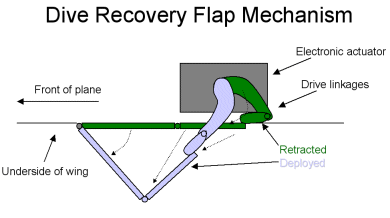Had a discussion with Odee about the flaps and dive flaps on the P-38L and told him I'd help clear up his confusion by posting the difference of the two.
In short, the Fowler Flaps used on the P-38 did not, nor was it intended to serve the same function of the dive flaps. The Fowler Flaps, in layman's terms, extends the wing area by extending on rails or slots.

The dive flaps were intended to serve an entirely different purpose, and that was to aid the P-38 in recovering in a high speed dive. Again, in layman's terms, it essentially changed the flow under the leading edge of the wing to prevent air turbulence over the elevators that caused "nose tuck" and make it easier for the pilot to recover from the high speed dive. Basically, it helped resolve the compressibility issue with the P-38.

As you can see from the two different images, both systems were different and not used for the same purposes. In addition, the Fowler Flaps couldn't be deployed at high speeds so it would have been useless in aiding the P-38 in recovering from a high speed dive or when it has entered into compressibility.
